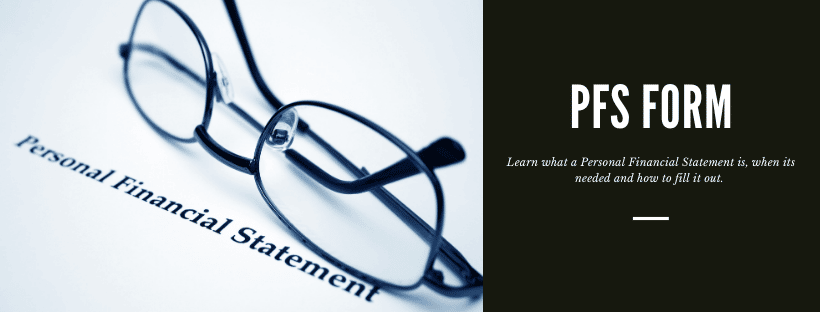How To Build a Personal Financial Statement For Commercial Loans

A personal financial statement is often among the required documentation when applying for a business loan. Even though business loans are distinct from personal loans, lenders might want to see the borrower’s personal financial situation for a variety of reasons.
If you’re applying for a business loan soon, here’s an explanation of what this document is and how to go about making a personal financial statement for a commercial loan application.
What is a Personal Financial Statement Form?
A personal financial statement form (PFS form) details an individual’s personal financial situation at a specific moment in time. Personal finances are distinct from business finances, and this is often the main document that shows lenders what a commercial borrower’s personal situation is like.
A PFS form details an individual’s financial situation by showing their net worth. The form includes assets, liabilities, and net worth, which is an individual’s assets less their liabilities. Net worth can be positive or negative, depending on whether an individual has more valuable assets or debts.
A personal financial statement shouldn’t be confused with a schedule of real estate owned (SREO). Whereas an SREO lists real estate that a business owns, a PFS lists property, other assets, and liabilities that an individual has.
(For individuals who are married, a personal financial statement form might encompass the family’s financial situation.)
Who Needs a PFS Form?
With regard to commercial loans, many applicants may be asked to provide a personal financial statement form. This is a standard document for recourse loan applications, and it’s frequently also used when underwriting non-recourse loans.
When the form is requested as part of a commercial loan application, any individual who owns a significant portion of the business and anyone who’s providing a personal guaranty will likely be asked to provide their own PFS forms.
A PFS form is also often a standard part of applying for a personal loan (which isn’t a commercial loan), and some individuals use the form to track their own financial situations.
How Do Commercial Lenders Use Personal Financial Statement Forms?
Commercial lenders may use a personal financial statement form for several different purposes. Depending on the specifics of the loan that’s being considered, a lender might use this document to:
- Verify Personal Guaranty: Lenders often use a PFS form to verify that a borrower is able to provide a personal guaranty when underwriting a recourse commercial loan.
- Check in Case of Bad-Boy Carve Outs: “Bad-boy carve outs” are select situations where a lender can personally pursue an individual borrower on a non-recourse loan. These generally include instances of fraud, gross negligence, and breaking a loan’s covenants. Lenders may want to check an individual’s financial position when underwriting non-recourse loans in case these apply in the future.
- Assess General Financial Management: When underwriting a recourse or non-recourse loan, lenders may ask for a PFS form to assess an individual’s general financial management. Lenders sometimes extrapolate that an individual will manage their business finances much like they do their personal finances.
- Meet Regulatory Requirements: Many non-recourse loans are regulated by federal agencies, and these agencies often require lenders to obtain PFS forms even if the forms have no bearing on an underwriting decision. Lenders occasionally ask for the form simply to meet regulatory requirements.
When Should You Create a Personal Financial Statement Form?
Investors should be prepared to send a personal financial statement form to a lender immediately after mankind an initial commercial loan inquiry. Because this is also a helpful document to track one’s own financial situation, maintaining a PFS form that’s updated monthly or quarterly is often wise.
Answer a few questions and get custom mortgage quotes. We'll match you with offers from our network of 650+ lenders.
How To Fill Out a Personal Financial Statement
A personal financial statement consists of four main sections, each of which should be clearly identified and logically filled out on the form. The sections are:
- Personal Details: The personal information that should be included in a PFS form includes an individual’s name, address, phone number(s), and email. These may be business or personal contact details.
- Assets: All personal assets should be listed on a PFS form. These may include an individual’s cash, stocks and bonds, retirement accounts, primary residence, other real estate, vehicles, and other valuable assets. Personal property such as jewelry or collectible art might be included, but common personal property like furniture and appliances isn’t valuable enough to consider. Business assets shouldn’t be included.
- Liabilities: All personal liabilities should be listed on a PFS form. These may include outstanding debts such as a mortgage, vehicle loans, other loans, and credit card balances. Business loans should’ be included.
- Net Worth: This is the sum of an individual’s assets (positive) less their liabilities (negative). Total net worth can be positive or negative.
Download a Printable Personal Financial Statement Form
Filling out a personal financial statement form is easy if you already have a template available. To begin your own PFS form, download our blank fillable personal financial statement form. The printable form is set up so that you can enter your personal details and financial information, and you’ll have a completed form that’s ready to submit with a loan application.


